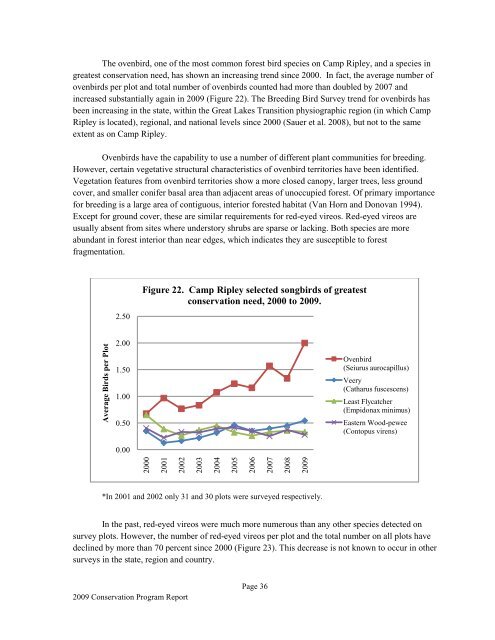camp ripley and arden hills minnesota army national guard training ...
camp ripley and arden hills minnesota army national guard training ...
camp ripley and arden hills minnesota army national guard training ...
Create successful ePaper yourself
Turn your PDF publications into a flip-book with our unique Google optimized e-Paper software.
The ovenbird, one of the most common forest bird species on Camp Ripley, <strong>and</strong> a species in<br />
greatest conservation need, has shown an increasing trend since 2000. In fact, the average number of<br />
ovenbirds per plot <strong>and</strong> total number of ovenbirds counted had more than doubled by 2007 <strong>and</strong><br />
increased substantially again in 2009 (Figure 22). The Breeding Bird Survey trend for ovenbirds has<br />
been increasing in the state, within the Great Lakes Transition physiographic region (in which Camp<br />
Ripley is located), regional, <strong>and</strong> <strong>national</strong> levels since 2000 (Sauer et al. 2008), but not to the same<br />
extent as on Camp Ripley.<br />
Ovenbirds have the capability to use a number of different plant communities for breeding.<br />
However, certain vegetative structural characteristics of ovenbird territories have been identified.<br />
Vegetation features from ovenbird territories show a more closed canopy, larger trees, less ground<br />
cover, <strong>and</strong> smaller conifer basal area than adjacent areas of unoccupied forest. Of primary importance<br />
for breeding is a large area of contiguous, interior forested habitat (Van Horn <strong>and</strong> Donovan 1994).<br />
Except for ground cover, these are similar requirements for red-eyed vireos. Red-eyed vireos are<br />
usually absent from sites where understory shrubs are sparse or lacking. Both species are more<br />
abundant in forest interior than near edges, which indicates they are susceptible to forest<br />
fragmentation.<br />
Average Birds per Plot<br />
2.50<br />
2.00<br />
1.50<br />
1.00<br />
0.50<br />
0.00<br />
*In 2001 <strong>and</strong> 2002 only 31 <strong>and</strong> 30 plots were surveyed respectively.<br />
In the past, red-eyed vireos were much more numerous than any other species detected on<br />
survey plots. However, the number of red-eyed vireos per plot <strong>and</strong> the total number on all plots have<br />
declined by more than 70 percent since 2000 (Figure 23). This decrease is not known to occur in other<br />
surveys in the state, region <strong>and</strong> country.<br />
2009 Conservation Program Report<br />
2000<br />
Figure 22. Camp Ripley selected songbirds of greatest<br />
conservation need, 2000 to 2009.<br />
2001<br />
2002<br />
2003<br />
2004<br />
2005<br />
2006<br />
Page 36<br />
2007<br />
2008<br />
2009<br />
Ovenbird<br />
(Seiurus aurocapillus)<br />
Veery<br />
(Catharus fuscescens)<br />
Least Flycatcher<br />
(Empidonax minimus)<br />
Eastern Wood-pewee<br />
(Contopus virens)
















